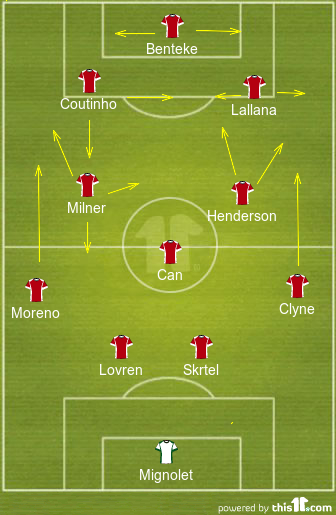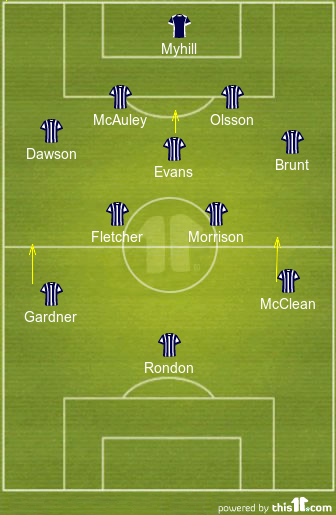Tactical Analysis: (Liverpool 2-2 West Brom)
Liverpool have been showing signs of optimism in recent weeks dispatching Chelsea, City and Southampton in style but struggling against lower well-drilled opposition most notably against Newcastle the previous week. The Baggies on the other hand, were looking to end their run of difficult matches with the trip to Anfield suffering only a single defeat in their previous four matches.
Klopp lost Sturridge but had Coutinho and Henderson back in contention while the Baggies were without Sessegnon who was replaced by Gardner.
Talking Tactics – First Half


Liverpool lined up in a narrow yet fluid 4-3-3 formation with the width mainly provided by the attacking wing-backs Clyne and Moreno. West Brom lined up in typical Pulis fashion in a defensive 4-5-1 formation.
Liverpool’s fluidity and quick tempo was visible right from the beginning as Coutinho had the goal at his mercy after exchanging positions with Benteke but missed the target. With Brom having all 10 outfield players in their own half, Skrtel and Lovren found themselves in the halfway line for the majority of the first half hour. Liverpool and Klopp had an interesting tactic which worked excellently against a well-drilled unit. With the front 3 exchanging positions with ease, Milner was asked to make runs out wide as an auxiliary left-winger to stretch the West Brom defence and more importantly, avoiding West Brom’s tight man-man marking.
The quick movement and position interchanges meant that Evans, Morrison and Fletcher could not look after the Liverpool midfield so easily. With Moreno and Clyne keeping McClean and Gardner occupied Liverpool sliced open the West Brom defence in scintillating fashion with an over the top ball tactic which they successfully attempted at least thrice including the first Coutinho chance in the first half. Milner, Can and Henderson were in a perfect line in the middle of the park when the move started. Milner passed it over to Can before making his move towards Benteke’s position who quickly moved left to occupy the space left by Coutinho who then found himself in the exact position where Milner had started the move. The only difference was that the line formed by Henderson and Can had cut off as Henderson took off and Can moved back. The movement was so lightening quick that the West Brom defence/midfield did not know whom to pick and left a gaping hole between left back and centre back which was perfectly exploited by a late run from Henderson who gave Morrison the slip.
While Liverpool were coming to grasp with Klopp’s attacking philosophy, it’s the defensive one which requires a bit of fine-tuning. The concept of pressing involves you to compress the field when you don’t have the ball and stretch it to maximum when you do. While the expansion was almost wonderful to watch, the compression left a lot to be desired with Can, Skrtel and Lovren making several defensive errors throughout the game. However, the Brom equaliser came as a result of a personnel error rather than a tactical one. The compression started leading to unnecessary fouls as they were aggressively confronting the opposition.
Second Half
Liverpool continued their aggressive pressing without the ball but were lacking precision. West Brom naturally the more defensive side only just edged out their opponents 10 to 9 in the fouls count. And the Baggies made full use of their set pieces with Olsson putting them in front through a corner. A serious injury to Dejan Lovren forced Klopp into making an attacking change at the 80’ min mark after which the game lost a bit of its tactical edge and became more open. Origi managed to equalise late into injury time to salvage a draw.
Key Areas and Summary
While there were no clear areas in which the game was decided apart from Set Pieces, The movement of the front 6 caused such a well drilled defensive unit some problems. This clearly explains why Liverpool found it easier against more attacking opposition as their movement is very hard to track. After years of disappointment and finishing second best, there are clear signs of optimism for the KOP especially if the pressing without the ball drastically improves.

